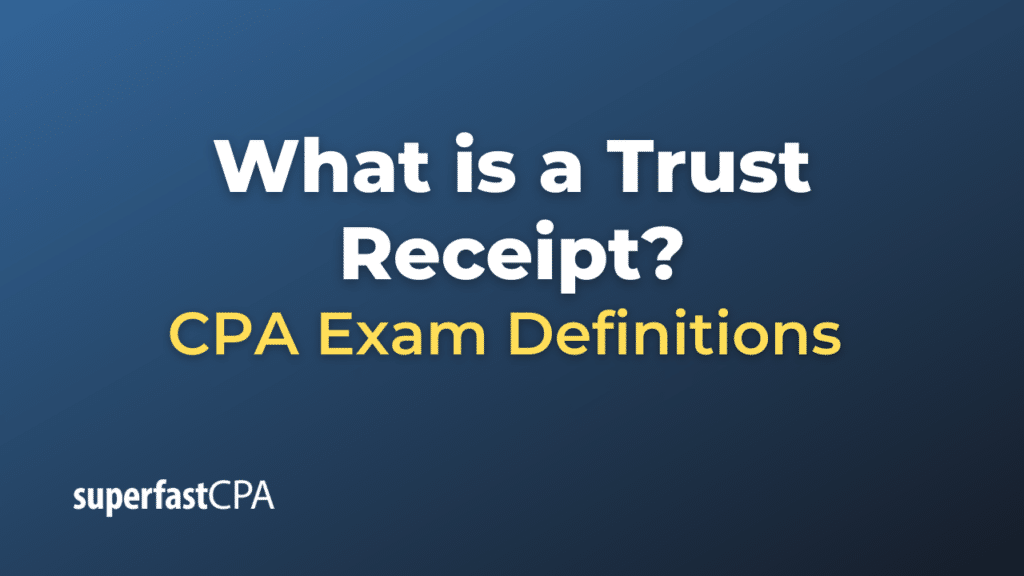Trust Receipt
A trust receipt is a financial arrangement where a bank allows a borrower to obtain goods, stored under the bank’s control, by agreeing that the borrower will sell the goods and repay the loan with the proceeds from the sale. In essence, the bank releases the goods or documents of title to the borrower but retains ownership until the loan is paid off.
Here’s how the trust receipt typically works:
- Import Financing: Often, trust receipts are used in international trade. A buyer/importer might need financing to bring goods into a country but does not have the necessary funds upfront. The buyer turns to a bank for help.
- Lien: The bank pays the seller/exporter on behalf of the buyer, and in return, the bank holds a lien on the goods as collateral.
- Release via Trust Receipt: Instead of keeping the goods, the bank provides the buyer with a trust receipt, which permits the buyer to take possession of the goods and sell them. The buyer is trusted to return the proceeds of the sale to the bank by a specific date, repaying the financing provided.
- Repayment: Once the buyer sells the goods, they must repay the bank from the proceeds. If the buyer fails to sell the goods or does not make enough from the sale, they still owe the bank the amount financed.
It’s important to note that the bank retains ownership of the goods or documents until the loan is fully repaid, even though physical possession is with the buyer. Trust receipts are beneficial for businesses that need to obtain inventory but lack the cash flow to do so. However, there’s a risk for banks because if the buyer can’t sell the goods or defaults on payment, the bank might need to recover and sell the goods themselves, potentially at a loss.
Example of a Trust Receipt
Let’s delve into a practical example to understand the workings of a trust receipt.
Scenario:
TechGears Ltd., an electronics retailer in the U.S., wants to import 1,000 high-end headphones from SoundMakers Inc., a manufacturer based in Germany. The total value of this order is $200,000. TechGears Ltd. does not have the funds to make this payment upfront but believes it can quickly sell these headphones in the local market due to their high demand.
The Trust Receipt Process:
- Initial Agreement: TechGears Ltd. approaches CapitalBank, a bank with which they have a good relationship, to request financing for the import. The bank agrees to help and confirms to SoundMakers Inc. that they will make the payment on behalf of TechGears Ltd.
- Payment and Lien: CapitalBank pays the $200,000 to SoundMakers Inc. Once the headphones reach the U.S. and are in the custody of CapitalBank, the bank holds a lien on them as collateral for the payment they’ve made.
- Release via Trust Receipt: TechGears Ltd. wants to take the headphones and sell them in its stores. CapitalBank agrees and provides TechGears Ltd. with a trust receipt. This receipt allows TechGears Ltd. to take possession of the headphones but acknowledges that CapitalBank retains ownership until the debt is repaid. The terms indicate that TechGears Ltd. must repay the $200,000 within 90 days.
- Sale and Repayment: TechGears Ltd. sells the headphones within 60 days for a total of $250,000, making a $50,000 profit. They then repay CapitalBank the owed $200,000 well before the 90-day deadline.
In this example, TechGears Ltd. successfully utilized the trust receipt arrangement to finance its inventory, while CapitalBank was repaid promptly and earned interest on the financed amount. This example paints a successful trust receipt scenario, but it’s worth noting that things can go awry if the borrower cannot sell the goods or if market conditions change drastically.













